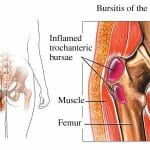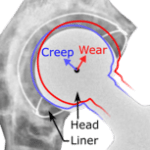
Hip pain when walking here’s how to fix it!
A lot of people suffer hip pain when walking here’s how to fix it! They may also experience sharp or severe hip pain when walking.
The hip pain doesn’t just happen when walking it can also occur when sitting, standing, or lying down.
Gradually it will affect every part of your daily life, I get this comment a lot“I get hip pain when I walk”.
What are the causes of hip pain and what are the best options for inflammation reduction to relieve hip and leg pain?
The Hip Joint
The hip joint is located at the joining of the femur (thigh bone) and the pelvis found in a socket known as the acetabulum. Within the hip joint the femur bone and the acetabulum of the pelvis are covered by cartilage, and the hip joint is surrounded by a joint lining tissue known as synovium.
This tissue creates fluid needed to oil the joint and deliver nutrition to the cartilage within the joint.
The femur bone is attached to the bony pelvis, the hip joint is surrounded by tendons and muscles that slide along the hip joint.
Bursae (small fluid-filled sacs) contribute to a smooth area around the hip joint for the muscles and tendons to work efficiently.
The biggest nerve in our bodies (sciatic nerve) is located behind the hip joint, important arteries are found at the front of the hip joint.
The main function of the large hip joint is to support the body weight and rotate when we are sitting standing or walking, it also provides stability.

Causes of hip pain
Hip pain can start by being slightly bothersome, sometimes it can be just temporary hip pain whilst other hip pain can chronic and long-lasting.
The causes of hip pain are many and include:
- Inflammation (Hip bursitis)
- Muscle strain
- Sciatica
- Iliotibial band syndrome
- Haematoma
- Infectious (Septic) arthritis
- Gaucher’s disease
- Avascular necrosis
- Arthritis (inflammatory and non-inflammatory)
- Tendinitis
- Osteoarthritis
- Wear and tear on the cartilage
- Infection
Symptoms of Hip Pain
Symptoms of hip pain include:
Tenderness, hip pain, hip and leg pain, swelling, groin pain, joint pain, and difficulty sleeping
The symptoms can vary from mild pain to more intense to more severe pain, it can lead to a disability.

Diagnosis of hip pain
Your doctor will start by asking about your health and family history, a physical examination will be done such as rotating the hip, and lifting the leg up and down from a lying down position to detect when the pain is at its worst or whether you have signs of sciatica.
Your doctor may refer you to a Hospital whereby an X-ray, a CT Scan, or in some cases an MRI will be performed to get a definite diagnosis of the cause of your hip.
Hip pain Treatments
Treatment of hip and or leg pain will most certainly depend on the cause of the problem, if your hip pain is caused by tendinitis, muscle strain, or osteoarthritis most common treatments include the use of anti-inflammatory meds.
If the inflammation is localized cortisone medication or injection may be used to reduce the inflammation.
If an infection is the cause of the hip pain antibiotics will be used, and a fracture may require surgical treatment using pins, plates, and screws, where there is severe arthritis a hip replacement is the only option.
The most common cause of hip pain

The most common cause of hip pain is wear and tear of the hip joint, it usually starts when we are younger and participating in sports that require repetitive use of the hip joint, sports such as football, rugby, soccer, and hockey.
You don’t have to have been a sports person to get hip pain it happens over time as we sit, walk, climb stairs or run.
Hip Bursitis
If you are diagnosed with hip bursitis this means that there is inflammation in the bursae which are the tiny fluid-filled sacs surrounding the hip and cartilage area.
This inflammation will have to be treated with either painkillers or my recommendation using a natural anti-inflammatory product used for many years in clinical settings for pain relief and inflammation reduction.
My Hip Bursitis story
I struggled with hip and leg pain for three years. At first, it didn’t seem to bother me too much, I had a kind of dull pain in my left outer hip area which would occur if I stood up in one spot for more than 10 minutes.
Gradually the pain would progress and affect me in more ways for example at work sitting down, climbing stairs, or while exercising and sleeping.
My diagnosis was hip bursitis, caused by inflammation of the bursa, tiny sacs of fluid surrounding the hip area, these little sacs of fluid are critical to the smooth movement of the hip, when the bursae become inflamed the result is excessive pain day in and day out
The pain rarely goes away unless one takes some strong painkillers, do we want a life of taking painkillers,?
There is a way to permanently remove hip bursitis pain
There is a way to remove hip bursitis pain permanently. It involves taking a proteolytic enzyme called Serrapeptase, one tablet per day to begin with on an empty stomach, depending on your pain level this can be increased to three maximum per day.
Serrapeptase was the only product that worked to get rid of the pain that I was experiencing without any side effects.
Serrapeptase is an enzyme extracted in a laboratory from the intestine of the silkworm, the main benefits of Serrapeptase are its amazing ability to get to the source of hip and leg pain namely inflammation and over time gets rid of the hip and leg pain altogether.
Serrapeptase dosage
For severe hip bursitis, it is recommended to take up to 3 x 250,000 IU Serrapeptase, to begin with per day, when the pain has gone reduced to a maintenance dose of one tablet per day.
Please note: As always discuss taking these natural supplements with your doctor, they do work please be patient it can take up to six months in some cases.
Related Articles:
Thanks for reading this article about hip pain when walking here’s how to fix it!




